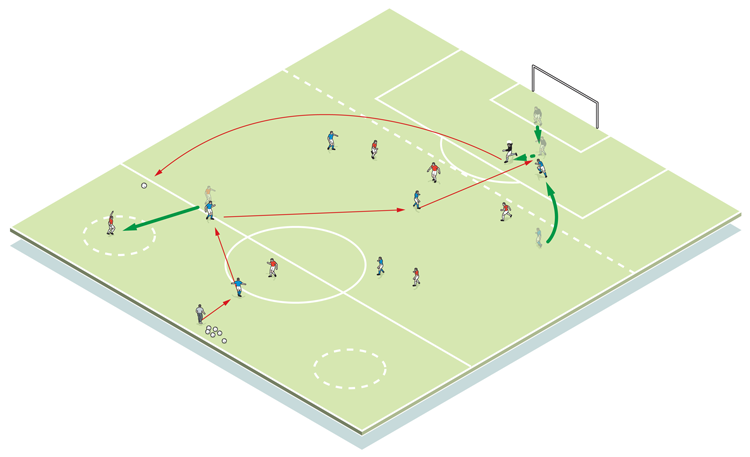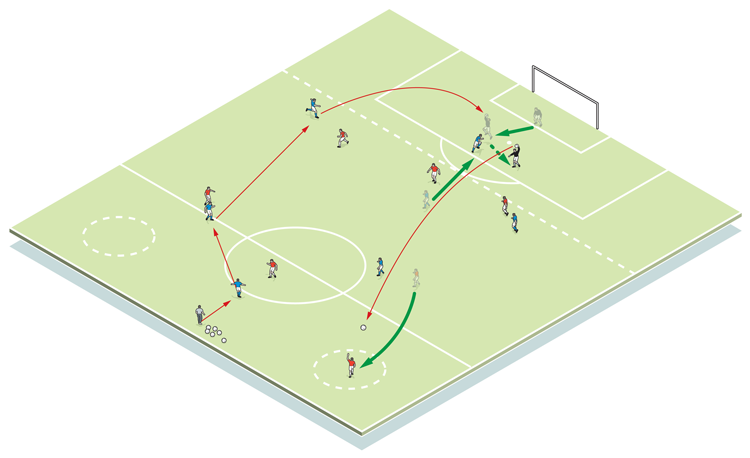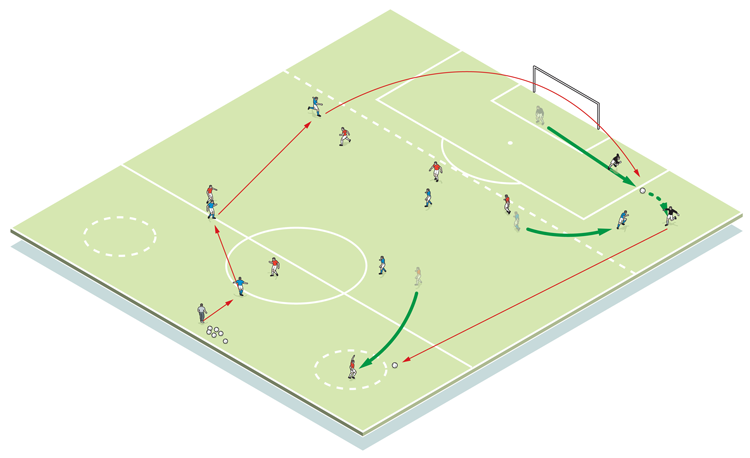




OUR BEST EVER OFFER - SAVE £100/$100
JOIN THE WORLD'S LEADING PROFESSIONAL DEVELOPMENT PROGRAMME
- 12 months membership of Elite Soccer
- Print copy of Elite Player & Coach Development
- Print copy of The Training Ground
The sweeper keeper
Using this session improves goalkeepers’ reading of the through-ball, and strengthens decision-making behind a back three or four.
| Area | Final third |
| Equipment | Balls, cones, goals, mannequins (optional) |
| No. of Players | Up to 12 |
| Session Time | Main session 15mins, Progression 15mins, Game 20mins |
This session improves goalkeepers’ reading of the through-ball, and strengthens decision-making behind a back three or four.
We run this practice because it’s so important in today’s game that keepers have a precise command of their area – after all, how often do we see keepers sent off for bringing an opponent down when through? Good goalkeeping should mean that penetration of the backline is anticipated and the threat dealt with.
I would suggest all keepers watch Tottenham Hotspur’s Hugo Lloris who, in the modern game, is the best at coming off his line.
What do I get the players to do?
Main session
We set up as shown, playing man-to-man, 7- or 8-a-side. There is no sweeper and nobody dropping off the defending team. That defending team must play in advance of the 22-yard line.
The attacking team tries to pick a pass through or over the top of the defence into the 22-yard area, sending a player through to score on goal. This can only be one man going through by himself, and cannot be two strikers. However, attackers can score from anywhere in the box after a through- pass or long pass into the coned area.
What are the key things to look for technically/tactically?
Keepers must have a realistic starting position, similar to the one they would adopt in a match. Of course, this would be dependent on where play was on the pitch, but a keeper cannot stay around the 22-yard line as this would be unrealistic.
Keepers must look to read the situations that develop in front of them. Communication between the keeper and his defenders is vital.
When the ball is sent towards goal, the keeper must assess the situation and make a decision to come or stay. If deciding to come, he must sprint to intercept the through-pass and either gather or clear (1).
1

How do I progress this game?
As a progression, we will tell the keeper to kick to one of the coned target areas when he intercepts the initial ball. Making a realistic transition from defence to attack is important, so we would also position two team mates on the pitch who can receive the keeper’s long pass in the target area (2).

It’s also important the attacking team varies the types of deliveries, with testing balls arriving both from the flanks and through the middle (3).
3

The keeper can also be encouraged to pursue other elements of being ‘the sweeper’ – for instance, if he intercepts the ball outside his area and is not under immediate pressure from an attacker, he can work on his long passes to a target player (4).
4

How would I put this into a game situation?
We would move this into a full-size 11-a-side game and instruct keepers to apply the principles outlined.
Related Files
Editor's Picks
Attacking transitions
Deep runs in the final third
Using the goalkeeper in build-up play
Intensive boxes drill with goals
Penetrating the final third
Creating and finishing
My philosophy
Pressing initiation
Compact team movement
Coaches' Testimonials

Alan Pardew

Arsène Wenger

Brendan Rodgers

Carlos Carvalhal

José Mourinho

Jürgen Klopp

Pep Guardiola

Roy Hodgson

Sir Alex Ferguson

Steven Gerrard
Coaches' Testimonials

Gerald Kearney, Downtown Las Vegas Soccer Club

Paul Butler, Florida, USA

Rick Shields, Springboro, USA

Tony Green, Pierrefonds Titans, Quebec, Canada
Join the world's leading coaches and managers and discover for yourself one of the best kept secrets in coaching. No other training tool on the planet is written or read by the calibre of names you’ll find in Elite Soccer.
In a recent survey 92% of subscribers said Elite Soccer makes them more confident, 89% said it makes them a more effective coach and 91% said it makes them more inspired.
Get Monthly Inspiration
All the latest techniques and approaches
Since 2010 Elite Soccer has given subscribers exclusive insight into the training ground practices of the world’s best coaches. Published in partnership with the League Managers Association we have unparalleled access to the leading lights in the English leagues, as well as a host of international managers.
Elite Soccer exclusively features sessions written by the coaches themselves. There are no observed sessions and no sessions “in the style of”, just first-hand advice delivered direct to you from the coach.







